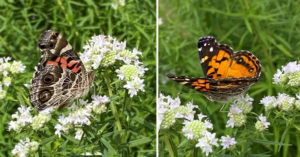(Photos and story by Diane De Luca)
The gardens are alive with pollinators. Visitors, campers, and those of us who work in the gardens are all drawn to the activity around the summer blooms. The tall purple spikes of the Anise Hyssop are buzzing with multiple species of bees. The white clusters of the Mountain Mint are also full of a wide diversity of pollinators with the Great Black Digger Wasp quite prominent. A wonderful opportunity for close focus on individual pollinators.
The butterflies catch my eye. Many flit quickly from one perch to the next, making it hard to examine the details of their markings. Others alight and share their full beauty. An American Lady butterfly lands atop one of the Mountain Mint clusters. At first the wings are open revealing the characteristic white dot on the orange interior of the wing. As the wings fold, and they begin to nectar, the key field mark for identification is revealed. The American Lady is distinguished from the Painted Lady by the two large black-ringed eyespots on the underside of the wing. The Painted Lady has five small eyespots.

The American Lady is one of the brush-footed butterflies. This is one of the largest and most diverse butterfly families that includes the Fritillaries, Admirals, Checkerspots, Tortoiseshells, among many others. They are called brush-footed because the forelegs are reduced and used only to clean the antennae and proboscis.
The American Lady is found throughout the United States in open habitat including fields, meadows, and roadsides. They commonly feed on nectar from plants such as aster, goldenrod, common milkweed and marigold. The larvae or caterpillars will use the pearly everlasting as a host plant. The adults will live two to four weeks while laying hundreds of eggs. The American Lady is known to migrate northward from southern states in the spring, but any southward migration is much reduced. The adults cannot overwinter in cold climates, but some pupa may survive. Spring populations are mainly from northward migration.
We can all create habitat that will support the American Lady and many other species of butterflies. If you have the space and are interested in supporting butterflies and other pollinators, diversity is the key. Supply nectar plants to offer life-sustaining food and host plants that provide egg laying sites and food for the larvae. Our pollinator gardens at both the McLane and Massabesic Centers demonstrate some options for plantings and share important information on pollinator conservation. Summer and fall are a great time to enjoy the many blooms in these gardens. We invite you to visit.
